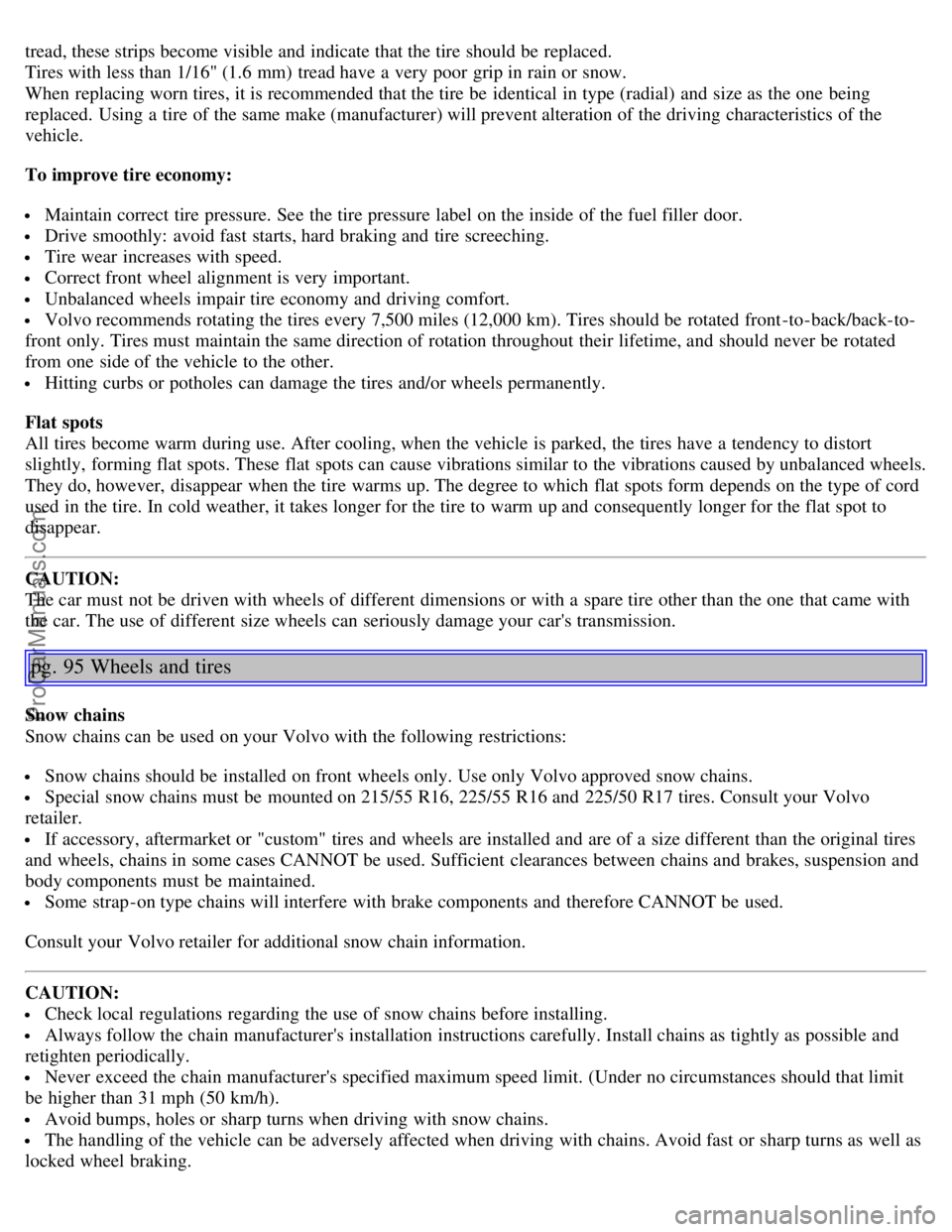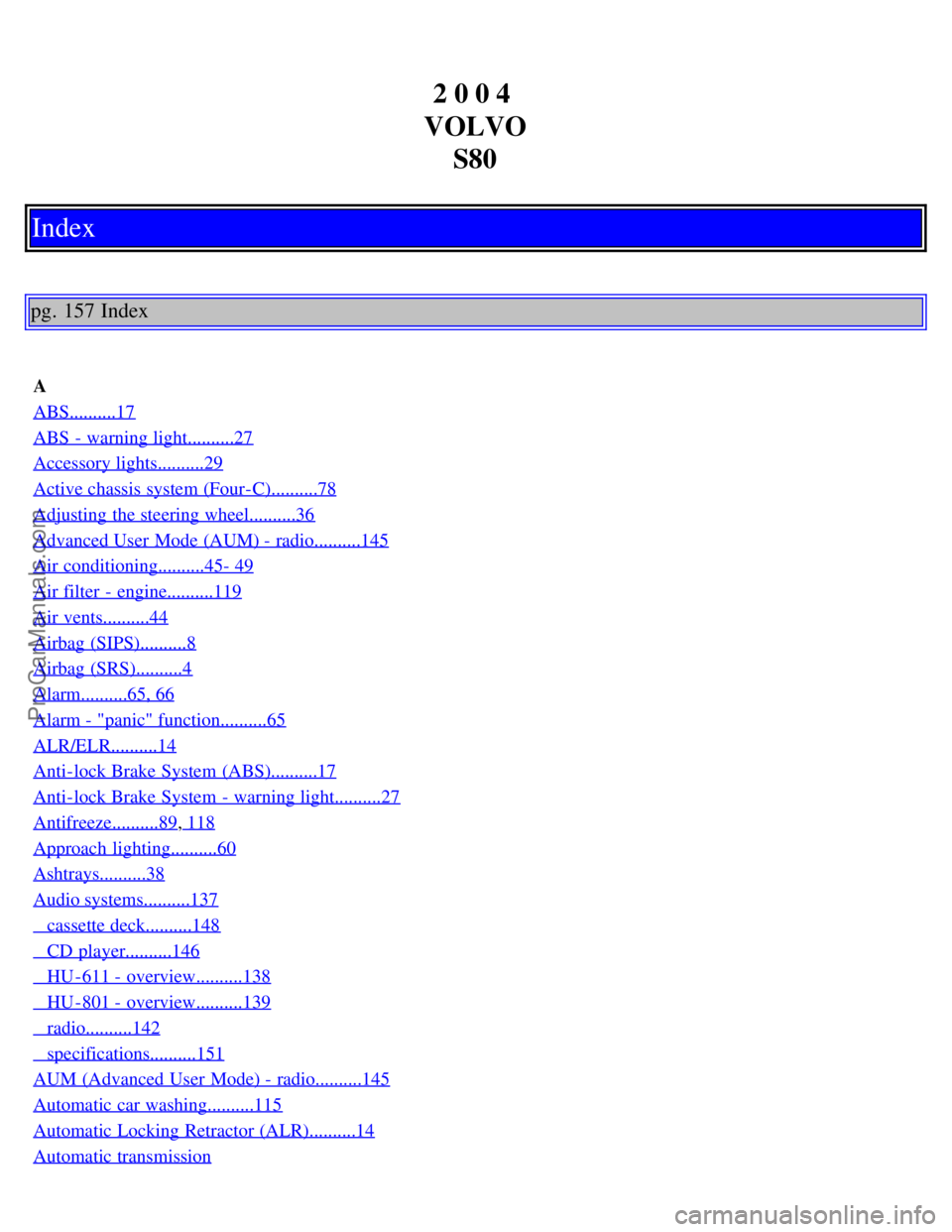2004 VOLVO S80 brake light
[x] Cancel search: brake lightPage 60 of 110

To temporarily deactivate the system:
Press the button in the center control panel (see illustration on page 29).
The LED in the button will go out to indicate that the system is not in active mode.
Press the button again to reactivate the system.
Faults in the system
If a fault should occur in the system, the LED in the button will be switched off and a message will be displayed in the
text window.
Cleaning the sensors
For the system to function properly, the sensors should be kept clean. They can be cleaned with car washing detergent
and a sponge.
WARNING!
This system is designed to be a supplementary aid when the vehicle is backing up. It is not, however, intended to
replace the driver's attention and judgement.
pg. 80 Driving economy
Economical driving conserves natural resources
Better driving economy may be obtained by thinking ahead, avoiding rapid starts and stops and adjusting the speed of
your vehicle to immediate traffic conditions. Observe the following rules:
Bring the engine to normal operating temperature as soon as possible by driving with a light foot on the accelerator
pedal for the first few minutes of operation. A cold engine uses more fuel and is subject to increased wear.
Whenever possible, avoid using the car for driving short distances. This does not allow the engine to reach normal
operating temperature.
Drive carefully and avoid rapid acceleration and hard braking.
Do not exceed posted speed limits.
Avoid carrying unnecessary items (extra load) in the car.
Maintain correct tire pressure. Check tire pressure regularly (when tires are cold).
Remove snow tires when threat of snow or ice has ended.
Note that roof racks, ski racks, etc., increase air resistance and also fuel consumption.
Avoid using automatic transmission kickdown feature unless necessary.
Avoid using the air conditioning when it is not required. When engaged, the A/C compressor places an additional
load on the engine. However, at higher driving speeds, fuel consumption will be lower with the air conditioning on and
the windows closed than with the air conditioning off and the windows open.
Using the onboard trip computer's fuel consumption modes can help you learn how to drive more economically.
Other factors that decrease gas mileage are:
Dirty air cleaner
Dirty engine oil and clogged oil filter
Dragging brakes
Incorrect front end alignment
Some of the above mentioned items and others are checked at the standard Maintenance Service intervals.
NOTE : Vehicles equipped with automatic transmissions should use (D)rive as often as possible and avoid using
ProCarManuals.com
Page 63 of 110

tread, these strips become visible and indicate that the tire should be replaced.
Tires with less than 1/16" (1.6 mm) tread have a very poor grip in rain or snow.
When replacing worn tires, it is recommended that the tire be identical in type (radial) and size as the one being
replaced. Using a tire of the same make (manufacturer) will prevent alteration of the driving characteristics of the
vehicle.
To improve tire economy:
Maintain correct tire pressure. See the tire pressure label on the inside of the fuel filler door.
Drive smoothly: avoid fast starts, hard braking and tire screeching.
Tire wear increases with speed.
Correct front wheel alignment is very important.
Unbalanced wheels impair tire economy and driving comfort.
Volvo recommends rotating the tires every 7,500 miles (12,000 km). Tires should be rotated front -to-back/back-to-
front only. Tires must maintain the same direction of rotation throughout their lifetime, and should never be rotated
from one side of the vehicle to the other.
Hitting curbs or potholes can damage the tires and/or wheels permanently.
Flat spots
All tires become warm during use. After cooling, when the vehicle is parked, the tires have a tendency to distort
slightly, forming flat spots. These flat spots can cause vibrations similar to the vibrations caused by unbalanced wheels.
They do, however, disappear when the tire warms up. The degree to which flat spots form depends on the type of cord
used in the tire. In cold weather, it takes longer for the tire to warm up and consequently longer for the flat spot to
disappear.
CAUTION:
The car must not be driven with wheels of different dimensions or with a spare tire other than the one that came with
the car. The use of different size wheels can seriously damage your car's transmission.
pg. 95 Wheels and tires
Snow chains
Snow chains can be used on your Volvo with the following restrictions:
Snow chains should be installed on front wheels only. Use only Volvo approved snow chains.
Special snow chains must be mounted on 215/55 R16, 225/55 R16 and 225/50 R17 tires. Consult your Volvo
retailer.
If accessory, aftermarket or "custom" tires and wheels are installed and are of a size different than the original tires
and wheels, chains in some cases CANNOT be used. Sufficient clearances between chains and brakes, suspension and
body components must be maintained.
Some strap -on type chains will interfere with brake components and therefore CANNOT be used.
Consult your Volvo retailer for additional snow chain information.
CAUTION:
Check local regulations regarding the use of snow chains before installing.
Always follow the chain manufacturer's installation instructions carefully. Install chains as tightly as possible and
retighten periodically.
Never exceed the chain manufacturer's specified maximum speed limit. (Under no circumstances should that limit
be higher than 31 mph (50 km/h).
Avoid bumps, holes or sharp turns when driving with snow chains.
The handling of the vehicle can be adversely affected when driving with chains. Avoid fast or sharp turns as well as
locked wheel braking.
ProCarManuals.com
Page 71 of 110

Ordinary fuses
LocationAmperage
1 Accessories 25A
2 Auxiliary lamps (option) 20A
3
4 Oxygen sensors 20A
5 Crankcase ventilation heater, solenoid valves 10A
6 Mass airflow sensor, engine control module, injectors 15A
7 Throttle module 10A
8 AC compressor, accelerator pedal position sensor, E-box fan 10A
9 Horn 15A
10 -
11 AC compressor, ignition coils 20A
12 Brake light switch 5A
13 Windshield wipers 25A
14 ABS/STC/DSTC 30A
15 -
16 Windshield washers, headlight wiper/washers (certain models) 15A
17 Low beam, right 10A
18 Low beam, left 10A
19 ABS/STC/DSTC 30A
20 High beam, left 15A
21 High beam, right 15A
22 Starter motor 25A
23 Engine control module 5A
24 -
pg. 104 Fuses in the passenger compartment
ProCarManuals.com
Page 73 of 110

38Alarm siren* 5A
* Please be aware that if this fuse is not intact, or if it is removed, the alarm will sound.
pg. 105 Fuses in the trunk
Fuses in the trunk
The fuses in the trunk are located behind the left panel. When replacing a blown fuse, be sure to replace it with a new
one of the same color and amperage (written on the fuse).
Ordinary fuses
Location Amperage
1 Rear electrical module, trunk lighting 10A
2 Rear fog light 10A
3 Brake lights (cars with trailer hitches only) 15A
4 Backup lights 10A
5 Rear window defroster, relay 15I - accessories 5A
6 Trunk release 10A
7 Folding rear head restraints 10A
8 Central locking rear doors/fuel filler door 15A
9 Trailer hitch (30 feed) 15A
10 CD changer, VNS 10A
11 Accessory control module (AEM) 15A
12 -
13 -
14
15 Trailer hitch (15I feed) 20A
16 Electrical socket in trunk - accessories 15A
17 -
18 -
ProCarManuals.com
Page 85 of 110

High beamH755W -
Low beam H755W -
Bi -Xenon headlights* (option) 35WD2R
Front parking lights 5WW 2.1x9.5d
Front direction indicators -21 W BAU 15s
Front fog lights H155 W -
Side marker lights -3 W W2.1x9.5d
Rear direction indicators -21W PY
Tail lights 675W/4cp BA 15
Brake lights LED
Backup lights 115621W BA 15
Rear fog light 115621/4W BA 15 d
License plate light -5 W W 2.1x9.5d
Door step courtesy lights
Front -5W SV 8.5
Rear -5W W 2.1x9.5d
Trunk lights -10 W SV 8.5
Glove compartment light -2 W BA 9s
Vanity mirror light(s) -12V 1.2 W
Instrument lighting -3 W W 2.1x9.5d
Rear ashtray -1.2 W W 2x4.6d
Front courtesy lights -10 W SV 8.5
Rear reading lights -5 W W2.1x9.5d
Sideview mirror -5W W2.1x9.5d
WARNING!
Bi -Xenon headlights (option) - due to the high voltage used by these headlights, these bulbs should only be replaced
by an authorized Volvo service technician.
Electrical system
12 Volt, negative ground.
Voltage-controlled generator. Single-wire system with chassis and engine used as conductors. Grounded on chassis.
Battery
Voltage: 12 Volt, capacity: 600 A/115 min. reverse capacity
The battery contains corrosive and poisonous acids. It is of the utmost importance that old batteries are disposed of
correctly. Your Volvo retailer can assist you in this matter.
Generator
Rated output: max. current: 140 A
Starter motor:
Output: 1.7 kW
All specifications are subject to change without prior notice.
pg. 136 On Call Roadside Assistance
ProCarManuals.com
Page 99 of 110

2 0 0 4
VOLVO S80
Index
pg. 157 Index
A
ABS..........17
ABS - warning light..........27
Accessory lights..........29
Active chassis system (Four-C)..........78
Adjusting the steering wheel..........36
Advanced User Mode (AUM) - radio..........145
Air conditioning..........45- 49
Air filter - engine..........119
Air vents..........44
Airbag (SIPS)..........8
Airbag (SRS)..........4
Alarm..........65, 66
Alarm - "panic" function..........65
ALR/ELR..........14
Anti-lock Brake System (ABS)..........17
Anti-lock Brake System - warning light..........27
Antifreeze..........89, 118
Approach lighting..........60
Ashtrays..........38
Audio systems..........137
cassette deck..........148
CD player..........146
HU -611 - overview..........138
HU -801 - overview..........139
radio..........142
specifications..........151
AUM (Advanced User Mode) - radio..........145
Automatic car washing..........115
Automatic Locking Retractor (ALR)..........14
Automatic transmission
ProCarManuals.com
Page 100 of 110

Geartronic..........76, 77
Kickdown..........76
Automatic transmission - cold starts..........75
Auxiliary socket..........29, 38
B
Backrests, rear seat - folding..........58
Battery..........89, 135
Battery maintenance..........125 -126
Replacing the battery..........126
Ventilation hose..........126
Blinds - rear/side rear windows..........42
Booster cushion..........13, 15
Booster cushion - integrated..........13
Brake failure warning light ..........26
Brake fluid..........124, 133
Brake system..........16
Bulbs (list)..........135
Bulbs - replacing..........106-112
C
Capacities (oils and fluids)..........129
, 133
Cargo net in trunk..........57
Catalytic converters - three-way..........91
Center console - switches..........29
Center head restraint - rear seat..........3
Central locking buttons..........63
Chains - winter driving..........95
Changing wheels..........98, 99
Chassis setting (R-models)..........69 78
Child booster cushion ......... 13, 15
Child Restraint Anchorages ........ 12
Child safety..........12 -15
Child safety locks - rear doors..........67
Climate controls..........45 - 49
Climate system - general information..........48
Clock..........25
Coat hanger..........53
Cold weather driving..........89
Combination filter..........45, 49
Coolant..........118, 133
Cooling system..........80, 133
Courtesy light..........54
Courtesy lights (front) - replacing..........112
Courtesy lights - exterior..........60
Cruise control..........31
ProCarManuals.com
Page 101 of 110

Cup holder - opening..........56
D
Dimensions..........131
Direction indicator bulbs (front)..........107
Direction indicators..........35
Distributor ignition system..........134
Door step courtesy lights - replacing..........110
Doors and locks..........60
Drive belt..........118
Driver's seat and remote keyless entry system..........53
Driving economy..........80
Driving mode indicator..........25
Driving mode W..........75, 77, 89
Driving with trunk open..........81
E
Economical driving..........80
Electrical system..........135
Electrical system - general information..........81
Electrically operated front seats..........52
Electrically operated moonroof..........41
Electrically operated sideview mirrors..........40
Electrically operated windows..........39
Electronic Brake Force Distribution..........17
Electronic Climate Control(ECC)..........45 - 49
Emergency Locking Retractor (ELR)..........14
Emergency towing..........83, 84
Emergency warning flashers..........37
Emissions systems..........117
Engine - specifications..........132
Engine - starting..........73
Engine air filter..........119
Engine compartment..........121
Engine oil..........89, 122, 123, 133
Exterior courtesy lights..........60
Exterior features - overview..........23
F
Fog light - rear..........27
, 32
Fog lights - front..........32
Folding head restraints..........29
Folding passenger's seat backrest..........53
Folding rear seat backrests ........58
Four-C (active chassis system).........29, 78
Front airbags - SRS..........4-7
Front airbags - SRS - warning light..........26
ProCarManuals.com